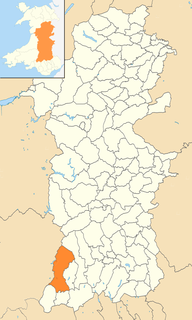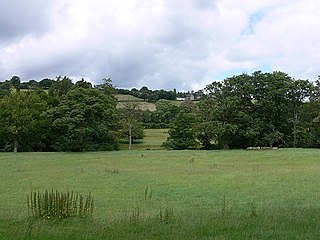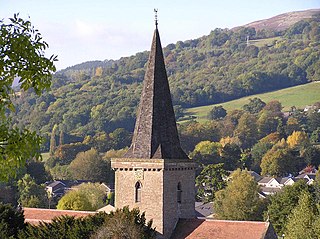Location
A Topographical Dictionary of Wales (1849) describes Glyntawe as, "a chapelry, attached to the parish of Devynock, in the hundred of Devynock, union and county of Brecknock, South Wales, 15 miles (W. S. W.) from Brecknock. It is situated at the south-western extremity of the extensive parish of Devynock, in a vale between elevated and dreary mountains, not far from the source of the river Tawe." Theophilus Jones in 1809 wrote of Devynock parish that,
The third chapel in this parish, in the vale of Tawe, is sometimes called Cael Glyntawe and sometimes Capel Callwen, a corruption of Cellwen, Fairwood chapel, or the chapel in the fair wood, descriptive no doubt of its early appearance; but so rude has been the hand of time and the equally denuding industry of man, so changed are the habiliments of nature in the course of ages, that she has here been disrobed of her verdant livery, which has been succeeded by a comfortless and slight russet mantle, incumbered by large stones and pebbles, and where the oak formerly grew in luxuriancy, the lichen at present barely vegetates."
Prehistory
A prehistoric site at Waun Fignen Felen, Glyntawe, has been carefully studied by paleo-ecologists and archaeologists. During the Mesolithic the area contained a small open lake that was gradually choked by weeds. At first it was surrounded by open country, but later this gradually changed to woodland. Stone tools and debris from knapping from the early and late Mesolithic were found in different locations around the lake. They seem to have been occupied only for short periods, and perhaps were hunting camps. Tools at the site are made of stones from some distance away, perhaps acquired by trade.
The Ogof yr Esgyrn cave at the source of the Afon Llynfell, part of a very large system of solution caves under the Cribarth plateau to the west of the upper Tawe, was discovered in 1922 and excavated between 1923 and 1950. Finds date from the post-glacial period through the Roman era to historic times. The cave was used for habitation and for burial. The strata from different eras were mixed together, and included a bronze rapier, bronze razor, bronze awl, gold bead, bone awl and weaving comb, as well as pottery sherds from the Bronze Age. [4]
History
In the Tudor period the Lord of Brecon owned several corn mills, including one in Glyntawe, called Melin Gaeth in Welsh, the villain's mill, where the villeins had to grind their corn. When Edward Stafford, 3rd Duke of Buckingham, was convicted of treason they became the property of the crown. Queen Elizabeth I of England granted the mills to one of the Herberts of Crickadarn for sixty years. In 1633 a decree of court established the right to compel tenants of the manor to bring their corn to the mills to be ground.
In 1836 a chapel in the parish of Defynnog, Brecknockshire, was dedicated to Saint Callwen. [lower-alpha 1] Capel Colwyn or St Colwen's in Callwen, Glyntawe, was a chapel of ease to Defynnog until around 1868, when Glyntawe became a separate parish. The Imperial Gazetteer of England and Wales (1870–72) described Glyntawe as "a hamlet-chapelry in Devynnock parish, Breconshire; 7½ miles W of Brecon town and r. station. Post town, Brecon. Pop., 99. Houses, 20. The living is a p. curacy in the diocese of St. David's. Value, £80. Patron, the Vicar of Devynnock." On 1 July 1893 a new Church of Saint Callewn was substituted for the older building in the parish of Glyntawe by Basil Jones, bishop of St David's. Historical census figures for the hamlet of Glyntawe are:
- 1841 - 118 people
- 1851 - 107
- 1861 - 99
- 1871 - 102
- 1881 - 133
- 1891 - 144
- 1901 - 147
The community was never industrialized. The people of Glyntawe would have farmed, worked in the quarries or in Penwyllt brickworks, or perhaps worked at Craig-y-Nos Castle. The church was rededicated to St John the Baptist in 1964–65, although it is still called Callwen Church by the locals. The school in Callwen was closed in 1970. [12]

Llansantffraed (Llansantffraed-juxta-Usk) is a parish in the community of Talybont-on-Usk in Powys, Wales near Brecon. The benefice of Llansantffraed with Llanrhystud and Llanddeiniol falls within the diocese of St David's in the Church in Wales.

Powys is a principal area and county, and one of the preserved counties of Wales. It is named after the Kingdom of Powys which was a Welsh successor state, petty kingdom and principality that emerged during the Middle Ages following the end of Roman rule in Britain.

Brecknockshire, also known as the County of Brecknock, Breconshire, or the County of Brecon is one of thirteen historic counties of Wales, and a former administrative county. Named after its county town of Brecon, the county is mountainous and primarily rural.

Llanwrtyd is a small settlement in Powys, mid-Wales, giving its name to a community, in the historic county of Brecknockshire (Breconshire), through which flows the River Irfon. It lies 1.5 miles north of the town of Llanwrtyd Wells.

Ystradgynlais is a town on the River Tawe in southwest Powys, Wales. It is the second-largest town in the principal area and county of Powys. Ystradgynlais is in the historic county of Brecknockshire. The town has a high proportion of Welsh language-speakers. The community includes Cwmtwrch, Abercraf and Cwmgiedd, with a population of 8,092 in the 2011 census. It forms part of the Swansea Urban Area where the Ystradgynlais subdivision has a population of 10,248.

Trecastle is a village in Powys, Wales, situated on the edge of the Brecon Beacons National Park (Welsh: Parc Cenedlaethol Bannau Brycheiniog) and in the community of Llywel.

Cathedine is a small hamlet that lies between the Brecon Beacons and the Black Mountains, in Powys, Wales. It is an approximately 2 miles from Llangorse and 2 miles from Bwlch, in the community of Llangors.
The Swansea Valley is one of the South Wales Valleys. It is the valley from the Brecon Beacons National Park to the sea at Swansea of the River Tawe in Wales. Administration of the area is divided between the City and County of Swansea, Neath Port Talbot County Borough, and Powys. A distinction may be drawn between the Lower Swansea valley and the Upper Swansea valley; the former was more heavily industrialised during the 19th and 20th centuries.

Capel-y-ffin is a hamlet near the English-Welsh border, a couple of miles north of Llanthony in Powys, Wales. It lies within the Black Mountains and within the Brecon Beacons National Park. The nearest town is Hay-on-Wye, some 8 miles (13 km) to the northwest.

Penwyllt is a hamlet located in the upper Swansea Valley in Powys, Wales.
This is a list of High Sheriffs of Brecknockshire or Breconshire.

Llywel is a small village located on the A40, about 4 miles (6.4 km) west of Sennybridge in Powys, Wales. The Afon Gwydderig runs through the village, not far from its source. Llywel also gives its name to a community. The main settlement in the community is Trecastle. According to the 2001 Census the population of Llywel community is 524, falling to 497 at the 2011 Census.

Coelbren is a small rural village within the community of Tawe Uchaf in southernmost Powys, Wales. It lies on the very northern edge of the South Wales Coalfield some six miles north-east of Ystradgynlais and just outside the southern boundary of the Brecon Beacons National Park. It is known for Henrhyd Falls, a 27m high waterfall which serves as a National Trust-managed visitor attraction on the Nant Llech. To the east of the village flows the Afon Pyrddin which plunges over two more spectacular falls.

The River Giedd is a principal tributary of the River Tawe, Wales. The river runs within the county of Powys and lies almost wholly within the Brecon Beacons National Park.

Defynnog, also known as Devynock in some historical documents, is a small village in the community of Maescar in the historic county of Brecknockshire, Wales, now lying within the unitary authority area of Powys. It lies immediately south of Sennybridge and about ten miles west of Brecon within the Brecon Beacons National Park.

Tawe-Uchaf is a community in Powys, Wales. Situated north-east of Ystradgynlais in the upper valley of the River Tawe, it includes the villages of Caehopkin, Coelbren, Glyntawe, Pen-y-cae, Penwyllt and Ynyswen. It had a population in 2001 of 1,516, increasing at the 2011 Census to 1,562.

Trallong is a village and community in Powys, Wales, in the historic county of Brecknockshire.

Penderyn is a rural village in Cynon Valley, Rhondda Cynon Taf, Wales, located near Hirwaun.
Saint Callwen was an early Welsh Christian saint from the Brychan family. There is some doubt about whether she existed. A church was dedicated to her in Defynnog, Brecknockshire.

St Edmund's Church is located in Crickhowell, in southeastern Powys, Wales. Built in the early 14th century, the church is dedicated to Saint Edmund the king and martyr. It has been known by this name from its establishment in 1303. In a will dated 1576 in the register office at Brecon, it is termed the parish of Saint Edmund. It is a Grade II* listed building.



















